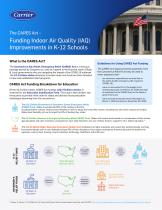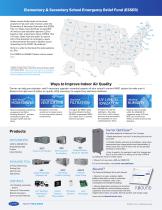Catalog excerpts

Funding Indoor Air Quality (IAQ) Improvements in K-12 Schools What is the CARES Act? The Coronavirus Aid, Relief, Emergency Relief (CARES) Act is a stimulus package passed by Congress as a way to respond to the financial need of State & Local governments who are navigating the impact of the COVID-19 outbreak. The $2.3 trillion-dollar allotment is broken down and funds are then funneled to new and established relief programs. CARES Act Funding Breakdown for Education Of the $2.3 trillion-dollar CARES Act funding, $30.75 billion-dollars is reserved for the Education Stabilization Fund. This fund is then divided into three parts to provide initial relief to states and districts facing education challenges stemming from the coronavirus. Guidelines for Using CARES Act Funding The CARES Act requires that the payments from the Coronavirus Relief Fund only be used to cover expenses that— • are necessary expenditures incurred due to the public health emergency with respect to (COVID–19); were not accounted for in the budget most recently approved as of March 27, 2020 (the date of enactment of the CARES Act) for the State or government; and were incurred during the period that begins on March 1, 2020 and ends on December 30, 2020. The $13.2 billion Elementary & Secondary School Emergency Relief (ESSER) Fund. States must allocate 90% of the funding to districts, including charter schools. Districts have flexibility on how to target the funds they receive, including how and which schools are funded. States have flexibility on how to target the 10% of funding they retain.1 The $3.0 billion Governor’s Emergency Education Relief (GEER) Fund. States will receive funds based on a combination of both schoolage population and rates of poverty, and governors have wide discretion over use of these funds to support K-12 or higher education.2 GOVERNOR’S RELIEF FUNDS The $14.25 billion Higher Education Emergency Relief Fund. Institutions of higher education will receive this funding directly, and they have broad latitude over its use, although at least 50% of their allocations must support emergency financial aid grants to students for expenses, such as food, housing, course materials, technology, healthcare and child care.3 LEAs choose how to use funds at least 90% via Title I Formula State Education Agencies (SEAs) Local Education Agencies (LEAs) Local Education Agencies (LEAs) Governors decide how to spend $ Higher Education Institutions State Governors Worley, S., Palmer, S. The CARES Act: Five Things That School & District Leaders Need to Know Now. April 23, 2020. https://www.wallacefoundation.org/news-and-media/blog/pages/the-c
Open the catalog to page 1
Elementary & Secondary School Emergency Relief Fund (ESSER) States receive funds based on the same proportion that each state receives under the Elementary & Secondary Education Act (ESEA) Title I-A. States must distribute at least 90% of funds to local education agencies (LEAs) based on their proportional share of ESEA Title I-A funds. States have the option to reserve 10% of the allocation for emergency needs as determined by the state to address issues responding to the COVID-19 pandemic.4 The CARES Act ESSER Tracker can be viewed here. Click on a state to download the state guidance to...
Open the catalog to page 2All CARRIER commercial catalogs and technical brochures
-
40UV-UH-14SI
32 Pages
-
42B-6SI
24 Pages
-
A WORLD OF COMFORT PRINT
10 Pages
-
A WORLD OF COMFORT
20 Pages
-
AirStream™ Room Fan Coils
4 Pages
-
A World of Comfort
2 Pages
-
Carrier-Catalogue-2018-2019
940 Pages
-
Axis™ Overhead Air Terminals
4 Pages
-
AERO® Air-Handling Units
4 Pages
-
19DV
32 Pages
-
30XA
136 Pages
-
30RAP
104 Pages
-
2019 Carrier Ductless
88 Pages
-
Carrier VRF
44 Pages
-
Special Seismic Compliance
1 Pages
-
Axis Overhead Air Terminals
2 Pages
-
Roomtop® 50AH036-072
24 Pages
-
OMNIZONE™ 50BV020-064
64 Pages
-
A World of Comfort
2 Pages
-
Low Noise Type CABINET FAN
16 Pages
-
Performance 16 Heat Pump
4 Pages
-
ComfortVIEW 3
6 Pages
-
VVT Zoning System
8 Pages
-
Heat Reclaim Chillers
2 Pages
-
Airstream Unit Ventilators
2 Pages
-
Airstream Room Fan Coils
2 Pages
-
Aero Air-Handling Units
2 Pages
-
17DA Centrifugal Chiller
2 Pages
-
AXIS? Overhead Air Terminals
3 Pages
-
Comfort? Series
2 Pages
-
GEMINI? 38AKS028-044
40 Pages
-
i-Vu Open Standard & Plus
2 Pages
Archived catalogs
-
ROOMAIR CONDITIONERS
6 Pages
-
AIRSTREAM™ Room Fan Coils
3 Pages
-
Water-Cooled Chillers
3 Pages
-
Antimicrobial Solutions
3 Pages





























































































